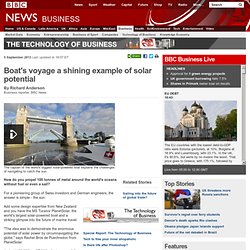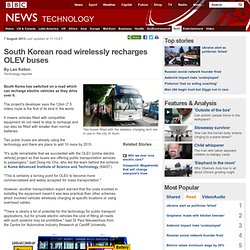

Boat's voyage a shining example of solar potential. 5 September 2013Last updated at 19:07 ET By Richard Anderson Business reporter, BBC News The captain of the world's biggest solar-powered boat explains the challenges of navigating to catch the sun How do you propel 100 tonnes of metal around the world's oceans without fuel or even a sail?

For a pioneering group of Swiss investors and German engineers, the answer is simple - the sun. Add some design expertise from New Zealand and you have the MS Turanor PlanetSolar, the world's largest solar-powered boat and a striking glimpse into the future of marine travel. "The idea was to demonstrate the enormous potential of solar power by circumnavigating the globe," says Rachel Bros de Puechredon from PlanetSolar. And with 60,000km (37,000 miles) successfully navigated, the team have achieved precisely that. Maximum exposure The Turanor uses energy harnessed from more than 500 sq m of solar panels to drive two, 60kW electric engines, each in turn driving a standard propeller.
Unique opportunity. World Solar Challenge 2013. Close-up look at UK's solar car race entry. Extra electric car charging points for Corby. Electric car charging points 'not being used' South Korean road wirelessly recharges OLEV buses. 7 August 2013Last updated at 11:13 ET By Leo Kelion Technology reporter Two buses fitted with the wireless charging tech are in use in the city of Gumi South Korea has switched on a road which can recharge electric vehicles as they drive over it.

The project's developer says the 12km (7.5 miles) route is the first of its kind in the world. It means vehicles fitted with compatible equipment do not need to stop to recharge and can also be fitted with smaller than normal batteries. Two public buses are already using the technology and there are plans to add 10 more by 2015. "It's quite remarkable that we succeeded with the OLEV [online electric vehicle] project so that buses are offering public transportation services to passengers," said Dong-Ho Cho, who led the team behind the scheme at Korea Advanced Institute of Science and Technology (KAIST). "This is certainly a turning point for OLEV to become more commercialised and widely accepted for mass transportation. " Smaller batteries. Hyundai to introduce hydrogen fuelled car by 2015. Sun guzzler: New solar family car pioneered in Holland. Technology - Lit Motors: Super-shrinking the city car.
One company wants to reinvent urban transportation by developing a fully enclosed, two-wheeled electric vehicle that puts less car and more people on the road.

Look around a city at peak traffic time and you’ll probably notice that most gridlocked cars contain only one person, despite having seating for four and space for their luggage. One option is ride-sharing schemes, which aim to have fewer cars and more people on the streets. There is a problem, according to Daniel Kim, Founder and CEO of Lit Motors: “Very few people actually like to carpool.” His company’s approach is different: shrink the car. Imagine if you could cut the size of a car in half, you could fit twice as many cars onto the streets, and into parking spaces. The solution that the San Francisco-based company hopes to roll out looks like a hi-tech, streamlined egg on two wheels.
The real innovation in the vehicle, though, is that it can stay upright, all by itself. Down-size desire? Technology - Juicing up: Hong Kong transport goes electric. Why Tesla Is Beating GM, Nissan and Ford. Premium Electric Vehicles. Battery Swap.